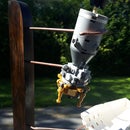Introduction: Comfortable Fur Saving Leather Dog Collar
When I designed this collar, I designed it with five criteria, in mind, and that went into its construction. It had to be strong, light weight, adjustable, comfortable and fur saving. To make it light I used 2-3 oz. vegetable tanned leather and incorporated a core of paracord to make it strong. This also acted as a, sort of, padding making the collar immensely more comfortable for dogs to wear. To make it adjustable, I used a three ring locking system. When clipped to the 'choker' ring, it would operate as a training collar, constricting gently around the dogs neck without cutting into it. You can turn it into a static collar by clipping to the large slip ring, or by clipping both the choker ring, and the offset ring, it can be made snug enough so that the dog cannot slip out of it.
Finally, unlike chain chokers or wide flat collars, the rounded leather collar does not pull on the dog's fur, eliminating the unsightly 'ring' dogs acquire over time from prolonged use. This is especially useful for show dogs, where they are judged by the perfection of their mane, but more importantly, the dog doesn't suffer the pain having its fur constantly pulled out, or the chafing associated with that.
I've tried other collars that claim to be 'fur savers', and with a dog, like mine who sports such a thick mane, I have yet to see one that lives up to its promises. I couldn't stand to see the ring around her neck that they left behind and the realization that her neck hair was being plucked out every time we went for a walk.
Step 1: Tools and Supplies
Tools:
- Sharp utility knife
- Stitching Awl
- Lighter or Torch
- Ruler
- Water spray bottle
- Cutting mat
- 3rd Hand Stitching Clamp (optional however you can check out my instructable here;
- https://www.instructables.com/id/3rd-Hand-Leather-S... )
Supplies:
- 2-3 oz leather
- Paracord
- 2 3/4" brass rings
- 1 1" brass ring
Step 2: Sizing Your Collar
Getting your dog to sit still for a collar sizing can be a task and a half, however failing that, you can use an existing one as a model. What I recommend is for the collar to sit around the base of the neck leaving room for your hand to fit inside of it comfortably. For my dog, a large breed German shepherd, it was 24" ring end to ring end.
You'll need to add an additional 1 1/4" on each end of your leather strip for the ring attachment. On mine it was 23" + 1 1/4" + 1 1/4" = 25 1/2". The width of your leather strip should be 1 1/16" to allow it to wrap around the cord and leave room for stitching.
Step 3: The Cord Core
Wrap one end of your cord around the 1" ring using heat to permanently attach it to itself. To reenforce the connection, use some waxed poly string and bind the end tightly. Don't attach the ring to the other end just yet.
Step 4: Punching Your Holes and Setting Your Ring
First, you'll need to taper the ends that wrap around the rings. Remove a 1/4" x 1 1/4" strip from each corner as in image #1. Next punch a row of stitching holes along each edge of the leather strip. Be sure to punch four more on each side of the tab created to secure the ring.
Optional
The offset ring isn't essential to the construction of the collar, but it can be useful for securing the collar around the dogs neck so that he/she can't slip out of it, while keeping it loose enough so as not to constrict. I recommend installing it if your dog is prone to slipping out of its collar frequently. Measure 4 1/2"- 5" from the 1" ring end and cut a 3/4" x 1/4" slot. I'll demonstrate how to install the ring into it later in this instructable.
Step 5: Installing the Ring and Stitching Your Collar
Lay the string down the inside of the leather strip. Fold the tab you created in the one end around the ring/string combo and fold it in half. Now, using your sewing awl, stitch all four layers together as demonstrated in Image #1. Make sure you secure it tightly as it'll need to handle the strength of the dog. Continue stitching the sides of the leather strip together, around the cord, using your awl, until you reach just before the place where you'll be setting the offset ring.
***Note** Going through 4 layers of leather can be tricky, even with 2-3 oz, but wetting you leather can go a long way to making the process easier. Use your spray bottle often during the construction process to keep the leather damp and pliant.
Step 6: The Offset Ring.
Take the loose end of the cord and feed it up through the notch you created, then through your 3/4" brass ring and back through the notch again. Now cut a 1.5" x 1/4" strip of leather and feed it through the notch following the same route as the string. Stitch it into place securely, and pull on the loose end of your cord to remove any slack.
**Note: The leather strip isn't essential, however it improves the aesthetic of the collar, as well as preventing the string from stretching out of the notch. I do, however, recommend installing it.
Once your offset ring is in place, continue stitching down the length of the collar until you reach the last 3-4 inches.
Step 7: Installing the Final Ring
Before you install the final ring, You'll need to feed the incomplete end through the 1" ring. Pull it through and slide it down, giving yourself plenty of slack to work with. If you don't, you won't be able to create a loop because of the offset ring.
Now you'll need to prep the ring in the same way that you did in step #3 using the smaller 3/4" brass ring, ensuring that it's length sits it inside the tab you've created. Fold over the tab and stitch it together in the same way that you did in step #4, burning the ends of your thread to prevent unraveling.
Step 8: Finishing
At this point, your collar is done and all that's left is to wet form it into shape. You can dye the leather, however I wouldn't recommend it as some dogs are allergic to dyes. You can acquire pre-dyed leather which is far less likely to leach onto your dogs fur, and would be the better choice if you want some color in your work.
As usual, I hope you enjoyed the instructable and thanks for following.

Third Prize in the
Animals Contest













